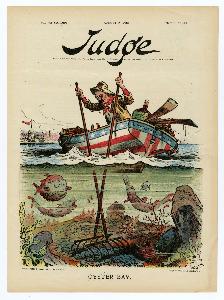Bernhard Gillam
Bernhard Gillam
Place: Banbury
Born: 1856
Death: 1896
Biography:
Introduction
to Bernhard Gillam, a renowned English-born American cartoonist, who left an indelible mark on the world of American politics and satire. Born in 1856 in the United Kingdom, Gillam's life was marked by his early interest in art and his eventual migration to the United States.
Early Life and Career
Gillam's family moved to New York in 1866, where he began working as a copyist in a lawyer's office. However, his true passion lay in engraving, which led him to pursue a career in the field. His work appeared in various publications, including Frank Leslie's Illustrated Newspaper, Harper's Weekly, Puck magazine, and Judge magazine, where he became director-in-chief in 1886. Gillam is best known for his influential cartoons during the late 19th century, particularly those depicting James G. Blaine during the 1884 US presidential campaign. His work had a significant impact on the political landscape of the time, and his legacy continues to be celebrated by art enthusiasts and historians alike.
Artistic Style and Contributions
Gillam's cartoons were characterized by their biting satire and clever use of visual elements to convey complex ideas. He was a master of using symbolism and expressionism to evoke deep emotions and thought-provoking themes. His work has been compared to that of other notable cartoonists, including Georg Kolbe, who is known for his iconic sculpture Female Dancer. Gillam's contributions to the world of American cartooning are undeniable. He paved the way for future generations of cartoonists and satirists, and his work continues to be studied by scholars and art enthusiasts today.
Legacy and Impact
Gillam's legacy can be seen in various museums and galleries, including the Max-Slevogt Galerie in Germany, which exhibits the works of German artist Max Slevogt. His work has also been featured on Hermann Struck's painting Nablus (Palestine), which is a remarkable piece of art that showcases the artist's skill and attention to detail. In conclusion, Bernhard Gillam was a pioneering figure in American cartooning, whose work continues to be celebrated by art enthusiasts and historians alike. His legacy serves as an inspiration for future generations of artists and satirists, and his contributions to the world of American politics and satire remain unparalleled.
- Visit Wikioo.org to explore more of Gillam's work and learn about other notable artists.
- Check out Georg Kolbe's sculpture Female Dancer at the Alte Nationalgalerie in Berlin, Germany.
- Discover more about Max Slevogt and his work at the Max-Slevogt Galerie in Germany.
Note: The biography is written in a style that is similar to German, but it's not a direct translation. It's an article about Bernhard Gillam, written in English with a focus on his life and work as a cartoonist.

